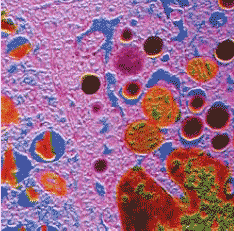Grow Your Own
GETTING A DIABETIC PANCREAS TO REGROW ITS ISLETS SCIENTIFIC AMERICAN Volume 293 Number 6, P. 25-26 | |
|
DANGER FROM RAISING
THE DEAD
Gastrin and epidermal growth factor show an ability to resurrect insulin-producing beta cells. Their side effects, however, are not clear yet and are being explored in human trials. Gastrin, at least, has a 10-year track record in ulcer patients who take proton-pump inhibitors. “All these patients have high blood levels of gastrin, not as high as what we’ll give, but still two to three times higher than normal,” says Alex Rabinovitch of the University of Alberta in Edmonton, who is leading the study. Yet if these growth factors disappoint, he says, plenty of others are under investigation. In unpublished animal studies, some of them appear to do an even better job of revving up beta-cell production. |
In 2000, when doctors at the University
of Alberta in Edmonton announced
that they had successfully
transplanted pancreatic islets into diabetic
patients, people around the world
began clamoring for the therapy. Because
islets secrete the right amount of
insulin at the right time, they can control
the concentration of glucose in the
blood far more precisely than a patient
can do, even with fi ve or six injections a
day. But islets must be harvested from
suitable organ donors, and there just are
not enough to go around.
Now another group, led by Alex
Rabinovitch at the same university, is
targeting a far better class of donors:
the patients themselves. By administering
chemical signals, or growth factors,
they hope to provoke the patients’ pancreas
to grow its own beta cells, which
are the insulin-making engines of the
islets. It would not be the fi rst such use
of a growth factor; for instance, erythropoietin
stimulates the production of
red blood cells. This time, however, the
object is not to speed up a process but to
restart one that has stopped.
In type 1 diabetes, the beta cells essentially
die off, victims of a ferocious
autoimmune reaction. But in the late
1970s autopsies revealed that a very few
beta cells continue to bud off from the
pancreatic ducts, apparently reproducing
the original process by which these
cells are born. Diabetologists had long
regarded duct cells as mere chaff, to be
removed from the islet tissue they were
trying to transplant. Now, however,
mounting evidence suggests that that
chaff may be pure gold.
“Our colleagues in surgery have a
paper saying that patients with the best
insulin response to islet transplantation
were those whose islets were most ‘contaminated’
with duct cells,” Rabinovitch
says. Why do patients benefi t from
added duct cells, seeing that they have
plenty of their own intact? He does not
know for sure but suspects that the duct
cells need to be cheek by jowl with the
islets to receive chemical feedback. He
has been studying many possible growth
factors and has struck pay dirt with two
of them.
One is gastrin, which is made in the
stomach, and the other is epidermal
growth factor, or EGF, an all-purpose
growth chemical. Their role in beta-cell
generation was fi rst suggested in 1993
by Stephen Brand and his colleagues at
Harvard Medical School. They found
an unusually large number of beta cells
in mice with mutations that caused
them to churn out more than the usual
amount of the two factors. Rabinovitch
reproduced the result by administering
the factors to a strain of mice bred to
model autoimmune diabetes.
 BETA CELLS (green and orange) in the islets of the pancreas secrete insulin. Growth factors could restore beta cells lost in type 1 diabetes. BETA CELLS (green and orange) in the islets of the pancreas secrete insulin. Growth factors could restore beta cells lost in type 1 diabetes. In newly diabetic mice, the results were spectacular. After two weeks of treatment, the beta-cell mass had tripled, the insulin content had increased eightfold, and the blood glucose concentration had fallen to normal levels. It did not go so well in mice with long-standing diabetes: their glucose levels fell substantially, yet they needed some immunosuppressive medication. That drug regimen made possible islet transplantation in the first place, but because it can damage the kidneys, it is suitable only for patients with dangerously uncontrolled diabetes. Even a partial regeneration in patients would at least get around the shortage of donor tissue and would probably require less immunotherapy; native cells would need defense from autoimmunity alone, not from that and organ rejection combined.
Phase II human trials of gastrin and EGF
began in August. They should yield results
on safety and effi cacy by the spring of 2006.
The enrolled subjects include those with
both type 1 and the more common type 2
diabetes, in which there is no autoimmune
reaction and the islets make insulin, but not
enough.
A great result, Rabinovitch says, would
be if the type 2 patients no longer needed
any insulin and if the type 1 patients could
get by with less. A little of the body’s own
insulin goes a long way, because beta cells
that produce it react so sensitively to the momentary
rise and fall of blood glucose. The
better the glucose control, the better the
patient’s chances will be for avoiding nerve
damage and other long-term complications
of diabetes
|